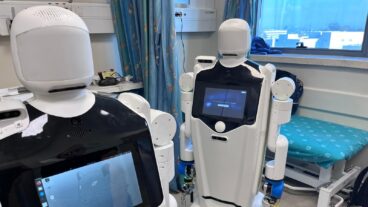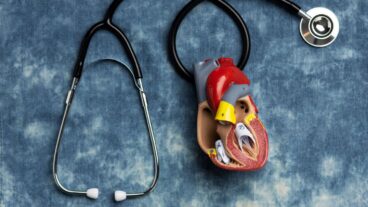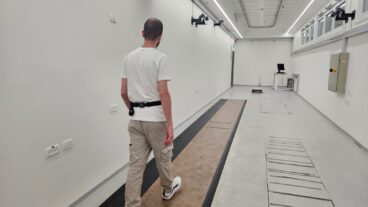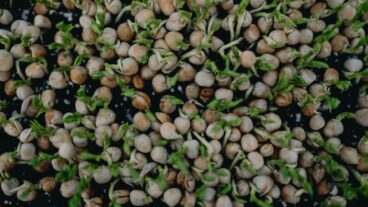Dr. Hamutal Slovin, of the Gonda Brain Center holds a pinecone from the brain tree which is reminiscent of the shape of the human brain.Understanding how the brain works is probably the greatest scientific puzzle of the 21st century. And an internationally recognized Israeli brain research center is providing a boost to discovering the subtle and mysterious workings of the brain – how it stores and processes information, and regulates animal and human behavior.
The multidisciplinary Gonda Brain Research Center at Bar-Ilan University recently hosted two forums attended by some of the top US brain researchers.
“I was thrilled to come to this extraordinary place,” said University of Chicago Professor Steven Small, editor of the journal Brain and Language who attended a forum on the same topic. “The psychology department is one of the best in the world.
Small also had high praise for Bar-Ilan Professor Miriam Faust, co-organizer of the forum. “Faust is one of the premier scientists on language and the brain in the world,” said Small.
Professor Mark Jung-Beeman, from Northwestern University, was equally enthusiastic: “I had a wonderful visit. I was very impressed with the people I met, the enthusiasm and knowledge of the audience, the whole Brain and Language Forum… and of course, the Gonda Brain Center building,” – a unique structure easily recognizable by its glass ‘brainwave’ design on its northern façade.
Jung-Beeman, an expert on the brain and creativity, and one of the top researchers in the world on problem solving in the left and right hemispheres of the brain, is collaborating with Faust on a research project dedicated to the study of how the brain processes metaphoric language. Their research – which uses functional magnetic resonance imaging (fMRI) based on changes in the level of oxygen in the blood that reaches the brain – recently revealed that different brain areas are activated in order to understand poetry and everyday language.
“We scanned brains to see when people need the left for syntax, and the right to process novel metaphors,” said Faust who supervised doctoral student Nira Mashal’s research.
“To process poetic expression, a unique network is recruited in the right temporal and frontal lobe of the brain,” Faust told ISRAEL21c.
The study – supported with a grant from the Binational Scientific Foundation (BSF) – was conducted in cooperation with Dr. Telma Hendler, Director of the Functional Brain Imaging Unit in the Sourasky Medical Center.
The second part of the Forum was devoted to clinical discussions of brain language relationships in dyslexia, when there is damage from strokes, tumors, injuries, and psychopathology.
According to the Gonda Center’s director, Professor Moshe Abeles, the uniqueness of the establishment lies in its multi-disciplinary approach.
“Individual disciplines can not solve many of the problems of the how the brain works. The Gonda Center is unique because it is in one physical building – biologists, psychologists, computational neuroscientists sit on the same floor. We give a lot of opportunity for informal interaction between researchers,” he told ISRAEL21c
“At a recent three-day annual retreat, a PhD student working on EEG analysis described a problem she was having measuring statistical relationships. A mathematics professor offered a solution on the spot.”
An internationally renowned neuro-physiologist, Abeles researches cell communication in the cerebral cortex in his lab. He was the first to discover the importance of exact spike timing – the pulse by which one neuron communicates with another in the cerebral cortex.
“Brain research has traditionally been at the forefront of research in the biological sciences in Israel,” said Abeles. “The number of researchers is relatively small, compared to Europe and the United States, but brain research is strong and the quality of brain research is relatively high.”
Drug addiction was the focus of another forum at the Gonda Center which attracted international attention. Dr.Yavin Shaham, Section Chief of National Institute of Drug Abuse (NIDA) and the National Institute of Health (NIH), was one of the key guest speakers, as well as Dr. Dorit Ron, University of California/San Francisco, an expert in alcohol addiction.
One of the NIDA’s top priorities is to find a medication to block or greatly reduce the effects of cocaine and to help alleviate the severe craving that people in treatment often experience. In 2004, an estimated 2 million Americans (ages 12 and over) reported using cocaine currently, 2700 new users a day.
“There is no effective treatment for cocaine addiction,” said Dr. Gal Yadid, Faculty of Life Science, Bar Ilan and head of the Neuropharmacology Laboratory in the Gonda Brain Center, who is studying the mechanism of addiction in the brain.
Looking for solutions, Yadid and his group studied the anti-aging natural steroid DHEA. “It is a potentially promising treatment for facilitating rehabilitation of cocaine addicts,” said Yadid. “DHEA is an anti-depressant lowering distress in cocaine withdrawal, and serves as protection against relapse following acute re-exposure.”
According to Yadid, two animal studies yielded important findings: In one, DHEA prevented cocaine-seeking behavior during early exposure. In the other, DHEA suppressed cocaine-seeking behavior during the maintenance phase when cocaine consumption is stable – suggesting its therapeutic potential as a supporting agent during withdrawal. In addition, reinstatement to cocaine use was dramatically reduced in rats treated with DHEA.
Preliminary clinical results of treating heroin addicts with DHEA – first presented at the meeting of the Israel Society for Treating Addiction earlier this year – have also shown promising results. The researchers reported that DHEA could significantly improve withdrawal symptoms, as well as depression and anxiety of the addicts. The study was conducted at the Methadone Treatment Center in Jaffa, in collaboration with the Biological Psychiatry Lab at Beilinson Medical Center.
While two-thirds of the heroin addicts had a fifty percent improvement, the data revealed a worsening effect in one-third of the addicts.
“We need to look for biological markers that differentiate between a positive and negative response. DHEA cannot be proposed as a therapy until we have more information,” said Yadid.
His team is also exploring another frontier of research – the use of nanoparticles to enhance drug treatment. A first in the treatment of substance abuse disorders, Yadid examined the use of GDNF (a growth factor), conjugated to tiny nanoparticles and introduced directly into the brain.
“We found that conjugation of GDNF to nanoparticles could extend the activity and availability of GDNF,” said Yadid.
Preclinical studies show reduced cocaine seeking-behavior of treated rats compared to the control group. “We think this raises the intriguing possibility that GDNF action attenuates the excessive overflow of dopamine, which modulates the rewarding effect of cocaine,” said the researchers in their article published in Experimental Neurology, in March 2005.












